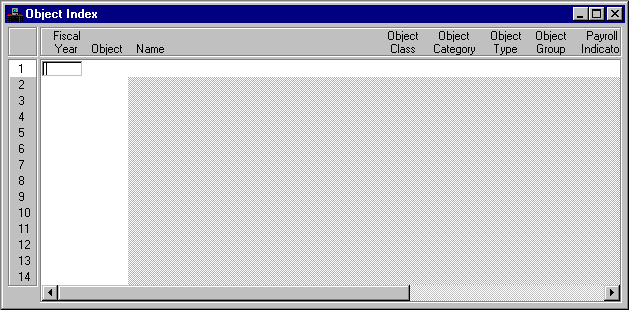Object Index (OBJT)
Object Index (OBJT) displays objects that may be used on expense budget and on spending and revenue documents. This window also displays higher level classifications of the object codes.
The object code is the starting point for a classification hierarchy that puts similar objects of expenditure together in progressively larger groups. The progression is as follows: 1). Sub-object; 2). Object; 3). Object class; 4). Object category; 5). Object type; and 6). Object group.
Object is the level used in the expense budget. Similar objects make an object class, and similar object classes make an object category. Sub-object codes are subdivisions of object codes.
An object code is always required. The rest of the hierarchy is used for reporting purposes only and is optional. You might use part of the object hierarchy or none at all.
|
|
|
|
Fiscal Year
|
Key field. Enter the last two digits of the applicable fiscal year.
|
|
Object
|
Key field. Enter the object value.
|
|
Name
|
The object name that was entered for this object value on Object (OBJ2) is displayed. If this is blank, no name appears on reports for this field.
|
|
Object Class
|
The object class from Object Class (OCLS) is displayed.
|
|
Object Category
|
The object category from Object Category (OCAT) is displayed.
|
|
Object Type
|
The object group from Object Group (OGRP) is displayed.
|
|
Object Group
|
The object type from Object Type (OTYP) is displayed.
|
|
Payroll Indicator
|
Indicates whether or not the object is payroll-related. Enter
Y
for payroll related objects; otherwise enter
N
. You may not enter requisitions and purchase orders with object codes identified as payroll-related.
|
|
1099 Type of Return
|
Indicates the type of return if expenses relating to this object are reportable under IRS standards for 1099 reporting (e.g.,
A
for 1099-Misc.).
|
|
FASB Class
|
Displays
U
if this account is unrestricted,
T
if it is temporarily restricted, or
P
if it is permanently restricted. This field is blank if a FASB classification is not associated with this account.
|




